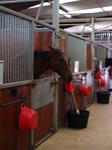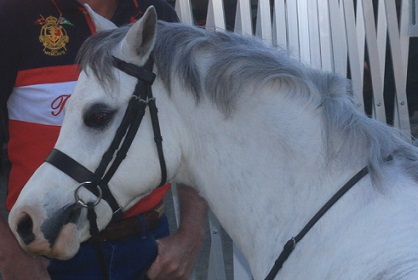 Learn to Manage the Health and Wellbeing of Horses; at Home and Away.
Learn to Manage the Health and Wellbeing of Horses; at Home and Away.
Study Equine care and management, online, and at home with this self paced e-learning course
- Work in the equine industry
- Follow your passion
- Learn from international experts, with decades of experience and university level training in equine science
The Lessons
There are 6 lessons in this course:
- Blankets, Bandages & Boots
- Different blankets and rugs
- fitting a rug
- putting on a rug
- taking off a rug
- surcingles and rollers
- caring for rugs and blankets
- types of bandages and their uses
- rules for bandaging
- boots and their uses
- Maintaining The Health Of Horses
- Signs of good and poor health
- sick nursing rules
- isolation procedure
- common ailments to recognize
- taking the temperature
- the medicine chest
- first aid treatments
- restraining a horse
- emergencies
- preventing a disease
- Clipping, Trimming & Plaiting
- Reasons for clipping
- types of clippers
- types of clips
- preparation for clipping
- how to clip
- finishing off
- hogging the mane
- trimming
- pulling the mane and tail
- plaiting the mane or tail
- Traveling & Care of The Horse Away From Home
- Preparing a horse for travel
- preparing a trailer
- loading the horse
- the problem loader
- safety while loading
- before a show
- at the show
- returning home
- Organising & Managing A Horse Event
- Organising an event
- contingencies to cater for
- the public, exhibitors and organisers
- costs
- guidelines for planning a show or exhibition
- the facility
- exclusive bookings
- facilities without prior bookings
- booking records
- publicity
- community participation
- Managing A Horse Enterprise
- management plans
- rural finance sources
- banks
- money market
- financial planning
- contract law
- assessing profit
- risk analysis
- standards
- financial records
- cash flow
- E.O.P accounting
Each lesson culminates in an assignment which is submitted to the school, marked by the school's tutors and returned to you with any relevant suggestions, comments, and if necessary, extra reading.
Course Duration: The average student will take around 100 hours of self paced study to complete this course.
LEARN TO TREAT A HORSE PROPERLY WHEN TRAVELLING

Horses are naturally suspicious of dark enclosed spaces. They become nervous when they cannot see for long distances around them and when they cannot run away from danger. These natural fears make a trailer a very frightening place for the horse.
Horse's can become used to traveling in trailers if they are patiently trained. The earlier this training starts the better. Ideally the young foal should follow his mother into a trailer so that he learns early on not to fear the enclosed space.
A good month should be set aside to train the older horse to load calmly into the trailer. The horse is initially walked around the box and allowed to smell it. Once a day the horse should be taken to the box and made a fuss of. Gradually, encourage the horse nearer to the ramp. After about a week, give the horse his evening meal at the bottom of the ramp. Slowly, day by day, move the feed bowl up the ramp until eventually the horse is eating his evening meal in the box without breaking into a sweat or showing signs of tenseness.
The next stage is to close the ramp behind the horse. Someone must stand within touching distance of the horse to calm him. Give the horse a hay net to take his mind off his confinement. Once the horse is happy to stand in the closed box he can be taken for a short drive to get him used to the trailer. Again, someone must be with the horse to keep him calm. Keep the speed slow and be particularly gentle when accelerating, braking and cornering. Remember that a heavy vehicle like a trailer takes longer to stop. Gradually lengthen the trip to half an hour. The horse should not sweat up or show signs of nervousness.
Some horses become extremely frightened in trailers because they fear falling. Modern trailers have narrow partitions. The easiest way for a horse to balance in a moving vehicle is to spread its legs out. This is impossible in a narrow space. If the horse persistently becomes panic stricken, it may be worth trying him in a wider box with the partitions removed so that he can brace his legs.
LEARN THE SIGNS OF ILL HEALTH IN A HORSE
 Familiarity with the signs of good horse health is essential to enable any signs of illness to be detected early in the disease process. The following are visual signs of health (good and poor) in horses.
Familiarity with the signs of good horse health is essential to enable any signs of illness to be detected early in the disease process. The following are visual signs of health (good and poor) in horses.
BEHAVIOUR
Attitude/Temperament
Normal: bright, alert with pricked ears and interest in surroundings.
Abnormal: aggressive, restless, depressed (+/- signs of pain such as unwillingness to move, head pressing, repeated yawning).
Stance & Stretching
Abnormalities may indicate regional pain (e.g. laminitis or abdominal pain).
Appetite
Eagerness and ability to eat and drink.
Defecation and urination
Normal/abnormal posture, frequency (defecation 8-12 times per day on corn, 16 times plus at pasture is normal), consistency (should break on hitting the ground), colour (green-brown to golden brown).
Presence of vices
Weaving, crib-biting, wind sucking indicate management problem and may have systemic consequences (e.g. weight loss etc.).
State of bedding
Disarray from pawing may be an indication of pain as may, straw on back if the horse has been rolling.
SUPERFICIAL SIGNS
Coat condition
Normal: shiny and even distribution.
Abnormal: include bald patches/changes in pigmentation which may be an indication of parasites, excess skin scurf (dandruff), and excessive growth (hormonal).
Skin lesions
Hairless patches, raised wheals, hemorrhages, tumors, moist mottled hair.
Body condition
Obese, normal, emaciated.
Abnormalities may be related to nutrition, management and/or disease.
Sweating
Excessive associated with pain and/or stress.
Discharges
From eyes or nose: amount and consistency, unilateral and bilateral.
RESPIRATION
Respiration Rate
Normal = 8-16 breaths per minute.
Nature
Normally respiratory effort should be barely noticeable, abnormal rhythm and involving abdominal effort indicates dyspnoea (difficulty in breathing).
Coughing
Frequency and nature (e.g. moist or dry +/- discharge).